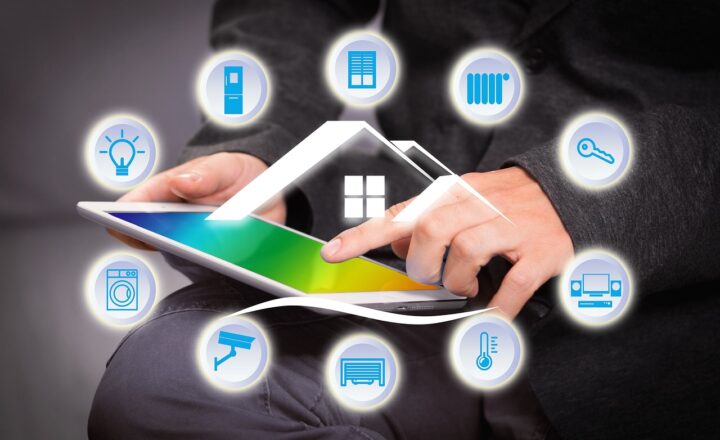
The concept of a smart home isn’t just the future—it’s the present. As we integrate technology into our daily lives, smart homes are becoming increasingly popular, offering convenience, security, and energy efficiency. Smart technology allows us to control various aspects of our homes, from lighting and temperature to appliances and security systems, all at the touch of a button or through voice commands. However, as smart homes evolve, so do the challenges and risks involved. This article explores how smart homes are reshaping our lives, the advantages they bring, and the potential hazards that come with increased connectivity.
1. Understanding Smart Homes
A smart home is one where devices and appliances are interconnected through the internet, allowing for remote monitoring and management. These devices can communicate with each other, often using a centralized hub or a smartphone app. From smart thermostats and lights to advanced security cameras, the growing market of smart home technology aims to enhance comfort and efficiency in our everyday lives.
Key Components of Smart Homes:
- Smart Lighting: Effortlessly manage your home’s lighting with timers and voice commands.
- Smart Thermostats: Control heating and cooling systems remotely, optimizing energy usage and saving on bills.
- Smart Security Systems: Monitor your home through security cameras and alarms accessible via mobile devices.
- Smart Appliances: From refrigerators that track food inventory to washing machines that can be controlled remotely.
The integration of these technologies offers unparalleled convenience, allowing homeowners to customize their living environment according to their needs. The appeal lies in productivity, energy savings, and enhanced comfort.
2. Advantages of Smart Homes
The smart home revolution isn’t just a trend; it’s changing how we live in significant ways. Here are some of the most compelling benefits of adopting smart home technology:
- Increased Convenience: Imagine turning off every light in your house without leaving your couch—smart technology makes this easy. Voice-activated assistants can perform multiple tasks, from playing music to managing your calendar.
- Enhanced Energy Efficiency: Smart thermostats and energy-efficient appliances can lead to significant savings on utility bills. They adapt to your routines, operating at full efficiency only when needed.
- Improved Security: Advanced security systems offer an extra layer of protection. With real-time surveillance and alerts, homeowners can monitor their property from anywhere in the world.
- Accessibility: For individuals with disabilities or mobility issues, smart technology can empower independence and make daily tasks more manageable.
These advantages illustrate why smart homes are rapidly capturing the market and becoming a common feature in modern living.
3. The Risks of Smart Home Technology
While the benefits of smart homes are substantial, it is crucial to address the significant risks that accompany this technology. With great convenience often comes increased vulnerability.
Potential Risks:
- Security Vulnerabilities: With devices connected to the internet, smart homes can be a target for cyberattacks. Hackers can exploit vulnerabilities to gain unauthorized access, potentially compromising your personal data and privacy.
- Privacy Concerns: Smart devices often collect data to function optimally. This constant monitoring raises concerns regarding how that data is collected, stored, and potentially shared.
- Interoperability Issues: Various devices and systems may not work seamlessly together, causing frustration for homeowners seeking universal control and convenience.
- Dependence on Internet Connectivity: A smart home relies heavily on a stable internet connection. Any disruptions can disrupt functionality, leaving you locked out of your home or unable to adjust your thermostat.
The risks highlight that while smart homes provide immense convenience, they also come with challenges that need careful consideration.
4. Best Practices for Smart Home Security
Ensuring the security of your smart home devices is paramount. Here are several best practices to help protect your connected home:
- Change Default Passwords: Always change default usernames and passwords. Use strong, unique passwords for different devices.
- Keep Software Updated: Regularly update the firmware of your devices to mitigate vulnerabilities.
- Use Two-Factor Authentication: Enable two-factor authentication whenever possible to add an extra layer of security.
- Segment Your Network: Create a separate network for your smart devices to keep them isolated from your primary network.
- Monitor Connected Devices: Regularly review the devices connected to your network and remove any that are no longer in use.
By taking proactive steps to secure smart home technology, homeowners can enjoy the benefits while minimizing the risks.
5. The Future of Smart Homes
The future of smart homes looks bright and transformative. As technology continues to advance, we can expect even more connected devices, greater interoperability among systems, and enhanced security features. The evolution of artificial intelligence (AI) will also play a pivotal role, creating a smarter, more responsive home environment that can learn and adapt to our behaviors over time.
Furthermore, as environmental concerns grow, eco-friendly smart home technologies featuring energy-efficient systems are becoming more prevalent. This marks a significant shift towards sustainable living within smart communities.
While there are challenges to overcome, the possibilities for innovation in smart homes are vast and encouraging. Ultimately, these advancements aim to make our lives easier, safer, and more efficient.
Conclusion
Smart homes represent a pivotal change in how we interact with our living spaces. They offer remarkable advantages in terms of convenience, efficiency, and security. However, homeowners must also be aware of the risks associated with increased connectivity and take steps to safeguard their devices and personal information. As we march towards a future where smart homes become the norm, understanding both the benefits and the challenges can empower us to make informed decisions that ensure our homes remain safe, secure, and connected.







